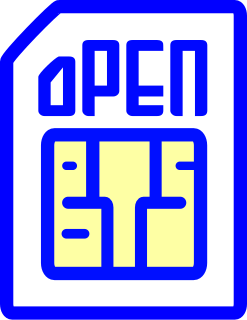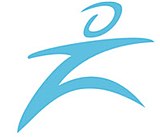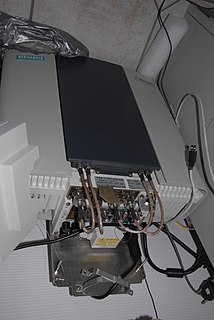General Packet Radio Service (GPRS) is a packet oriented mobile data standard on the 2G and 3G cellular communication network's global system for mobile communications (GSM). GPRS was established by European Telecommunications Standards Institute (ETSI) in response to the earlier CDPD and i-mode packet-switched cellular technologies. It is now maintained by the 3rd Generation Partnership Project (3GPP).
The Universal Mobile Telecommunications System (UMTS) is a third generation mobile cellular system for networks based on the GSM standard. Developed and maintained by the 3GPP, UMTS is a component of the International Telecommunications Union IMT-2000 standard set and compares with the CDMA2000 standard set for networks based on the competing cdmaOne technology. UMTS uses wideband code division multiple access (W-CDMA) radio access technology to offer greater spectral efficiency and bandwidth to mobile network operators.

Software-defined radio (SDR) is a radio communication system where components that have been traditionally implemented in hardware are instead implemented by means of software on a personal computer or embedded system. While the concept of SDR is not new, the rapidly evolving capabilities of digital electronics render practical many processes which were once only theoretically possible.

In IEEE 802 LAN/MAN standards, the medium access control (MAC) sublayer is the layer that controls the hardware responsible for interaction with the wired, optical or wireless transmission medium. The MAC sublayer and the logical link control (LLC) sublayer together make up the data link layer. Within the data link layer, the LLC provides flow control and multiplexing for the logical link, while the MAC provides flow control and multiplexing for the transmission medium.
The 3rd Generation Partnership Project (3GPP) is a standards organization which develops protocols for mobile telephony. Its best known work is the development and maintenance of:

WiMAX is a family of wireless broadband communication standards based on the IEEE 802.16 set of standards, which provide multiple physical layer (PHY) and Media Access Control (MAC) options.
The GPRS core network is the central part of the general packet radio service (GPRS) which allows 2G, 3G and WCDMA mobile networks to transmit IP packets to external networks such as the Internet. The GPRS system is an integrated part of the GSM network switching subsystem.

The base station subsystem (BSS) is the section of a traditional cellular telephone network which is responsible for handling traffic and signaling between a mobile phone and the network switching subsystem. The BSS carries out transcoding of speech channels, allocation of radio channels to mobile phones, paging, transmission and reception over the air interface and many other tasks related to the radio network.
Customized Applications for Mobile networks Enhanced Logic (CAMEL) is a set of standards designed to work on either a GSM core network or the Universal Mobile Telecommunications System (UMTS) network. The framework provides tools for operators to define additional features for standard GSM services/UMTS services. The CAMEL architecture is based on the Intelligent Network (IN) standards, and uses the CAP protocol. The protocols are codified in a series of ETSI Technical Specifications.

A PHY, an abbreviation for "physical layer", is an electronic circuit, usually implemented as a chip, required to implement physical layer functions of the OSI model.

A Medium Attachment Unit (MAU) is a transceiver which converts signals on an Ethernet cable to and from Attachment Unit Interface (AUI) signals.

Universal Software Radio Peripheral (USRP) is a range of software-defined radios designed and sold by Ettus Research and its parent company, National Instruments. Developed by a team led by Matt Ettus, the USRP product family is intended to be a comparatively inexpensive hardware platform for software radio, and is commonly used by research labs, universities, and hobbyists.

Node B is the telecommunications node in particular mobile communication networks, namely those that adhere to the UMTS standard. The Node B provides the connection between mobile phones (UEs) and the wider telephone network. UMTS is the dominating 3G standard.
Communications servers are open, standards-based computing systems that operate as a carrier-grade common platform for a wide range of communications applications and allow equipment providers to add value at many levels of the system architecture.

OpenBTS is a software-based GSM access point, allowing standard GSM-compatible mobile phones to be used as SIP endpoints in Voice over IP (VoIP) networks. OpenBTS is open-source software developed and maintained by Range Networks. The public release of OpenBTS is notable for being the first free-software implementation of the lower three layers of the industry-standard GSM protocol stack. It is written in C++ and released as free software under the terms of version 3 of the GNU Affero General Public License.
The Um interface is the air interface for the GSM mobile telephone standard. It is the interface between the mobile station (MS) and the Base transceiver station (BTS). It is called Um because it is the mobile analog to the U interface of ISDN. Um is defined in the GSM 04.xx and 05.xx series of specifications. Um can also support GPRS packet-oriented communication.

SIMCom Wireless Solutions is a subsidiary of SIM Technology Group Ltd. It is a fast-growing wireless M2M company, designing and offering a variety of wireless modules based on GSM/GPRS/EDGE, WCDMA/HSDPA and TD-SCDMA technical platforms

A remote radio head (RRH), also called a remote radio unit (RRU) in wireless networks, is a remote radio transceiver that connects to an operator radio control panel via electrical or wireless interface. When used to describe aircraft radio cockpit radio systems, the control panel is often called the radio head.
C-RAN (Cloud-RAN), sometimes referred to as Centralized-RAN, is an architecture for cellular networks. It was first introduced by China Mobile Research Institute in April 2010 in Beijing, China, 9 years after it was disclosed in patent applications filed by U.S. companies. Simply speaking, C-RAN is a centralized, cloud computing-based architecture for radio access networks that supports 2G, 3G, 4G and future wireless communication standards. Its name comes from the four 'C's in the main characteristics of C-RAN system, "Clean, Centralized processing, Collaborative radio, and a real-time Cloud Radio Access Network".
















